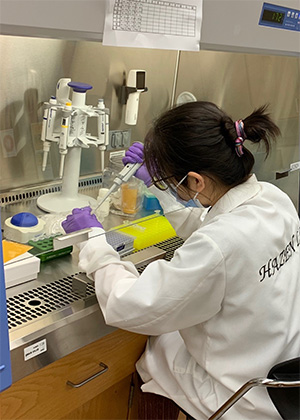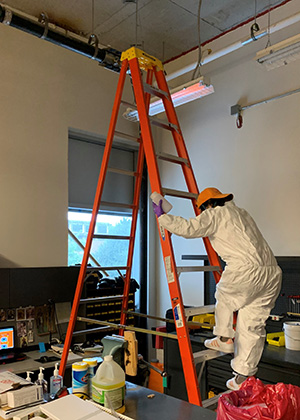Waste Makes Haste: Sewage and Swift Action Helped Control the Spread of Covid-19
By August of 2020, SARS-CoV-2—the virus that causes Covid-19—had claimed almost a million lives. Global awareness was focused on what everyone was breathing in.
In Knoxville, seven people were focusing on what everyone was flushing down.
“Wastewater-based epidemiology (WBE) can be an effective tool for early detection and monitoring of viral outbreaks,” said Ye Li, a PhD student working with Terry C. Hazen, the UT-Oak Ridge National Laboratory Governor’s Chair for Environmental Biotechnology.
In WBE, researchers test raw sewage for copies of a target virus. High concentrations of the virus indicate that the people upstream of the sampling site are infected, heralding the start of an outbreak—and revealing where preventative measures will have the highest impact.
To gather that life-saving data, Li and the other researchers had to gather potentially virus-laden wastewater before any vaccines were available.
“Initially, I did have concerns about the potential infection risk,” Li said, “but it was an important opportunity to help control the spread of the virus. Dr. Hazen also took every precaution to ensure our safety. Our process was rigorously reviewed by UTK Environmental Health and Safety.”
Every week for a full year, the team monitored the waste of more than 8,000 students, gathering more than 1,500 samples from the 45 residential buildings on campus.
“If we found that a building was high for SARS-CoV-2, the Student Health Center (SHC) would immediately collect pooled saliva samples from students living in different parts of the building,” said Li. “If a pool came back positive, each of the students in that pool was sent to the SHC to get a clinically certified test.”
This method allowed UT to efficiently allocate healthcare resources to students who were at the highest risk of infection, significantly reducing the cost of Covid-19 management and the strain on the SHC—but it was also grueling, sometimes requiring Li and Postdoctoral Fellow Kurt Ash to work past midnight.


Besides the exhausting pace, Hazen’s team faced another issue: no one was sure how long SARS-CoV-2 remained detectable in wastewater.
“Stored wastewater samples can be utilized to trace back and understand the timeline of a virus’s arrival and spread within a community,” said Li. “However, laboratories with limited equipment have to store samples in 4°C (39° F) refrigerators for extended periods before analysis.”
Adding to the problem, early WBE studies on SARS-CoV-2 focused on influent wastewater, the sewage just entering a treatment plant. However, influent wastewater includes business and industrial waste, diluting the viral signal, and has spent some time in the sewer system—where the water temperature can reach 25° C (77° F).
“Those elevated temperatures can accelerate the degradation of RNA, potentially impacting the detectability of the SARS-CoV-2 virus in sewage samples,” Li said.
While the high-temperature decay rate of the virus was not an immediate issue for the UT team, they recognized the impact that type of data could have on global Covid-19 control efforts.
Therefore, in an article published in Frontiers in Microbiology this April, Li and her colleagues reported the decay rates of SARS-CoV-2 RNA in wastewater stored at different temperatures.
Li found that the SARS-CoV-2 in samples stored at 20° C (68° F) degraded almost two times faster than the RNA in refrigerated samples, but that the virus was still detectable for almost nine days.
“This result means accurate analysis is possible even when immediate processing is not available,” said Li. “This can lead to more efficient and cost-effective epidemiological studies, especially in situations where large-scale sample storage is necessary.”
With Hazen and Li’s team working in tandem with UT administrators and the SHC, the UT campus maintained lower SARS-CoV-2 infection rates than Knoxville as a whole—not even registering some of the intense spikes seen in Knox County.
While the Federal Covid-19 Public Health Emergency officially ended last month, Li has several plans for future studies of the virus, such as investigating how demographic and socioeconomic factors impact the persistence and dynamics of SARS-CoV-2 in wastewater.
“Understanding how community-level characteristics influence viral loads, transmission patterns, and the effectiveness of wastewater surveillance can aid in interpreting WBE data, identifying high-risk areas, and informing targeted public health interventions,” she said.
Contact
Izzie Gall (865-974-9387, egall4@utk.edu)
![The Hazen lab’s wastewater sampling team. From left to right: Terry C. Hazen, Kurt Ash, Isabella Alamilla, Ye Li, Dominique C. Joyner, Peter McKay [and Daniel E. Williams, not pictured].](https://tickle.utk.edu/wp-content/uploads/2023/06/CEE-SamplingTeam-Li.jpg)